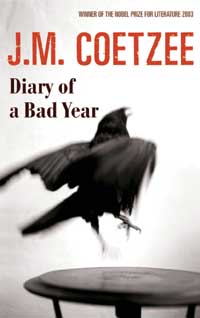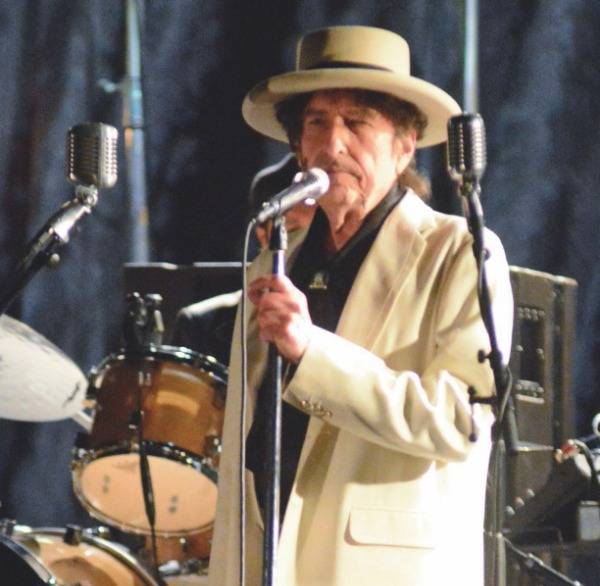JM Coetzee has been a consistent critic of the pretensions of humanism, including the ideal that literature can redeem us, can help us find a humane way of living with each other. But Diary of a Bad Year, his thirteenth novel, may do just this.
Since the early novels Dusklands (1974) and In the Heart of the Country (1977), and especially Waiting for the Barbarians in 1980, whether writing directly about South Africa or a more allegorical mode Coetzee has been the South African writer who addressed a universal audience.
 When he was awarded the Nobel Prize for Literature in 2003, he was identified in dominantly universal terms. The Nobel Committee announced him as a writer “… who in innumerable guises portrays the surprising involvement of the outsider.” He asked the Big Questions: the tensions between living a life and imagining lives (the “incompatibility and inseparatability of literature and life” in the Committee’s words); how to struggle for dignity against extreme adversity and repression; the sense of growing disorder and barbarism; passivity as the last resort to human beings who defy an oppressive order by making themselves inaccessible to its intentions; and the personal and political manifestations of shame, disgrace and dishonour.
When he was awarded the Nobel Prize for Literature in 2003, he was identified in dominantly universal terms. The Nobel Committee announced him as a writer “… who in innumerable guises portrays the surprising involvement of the outsider.” He asked the Big Questions: the tensions between living a life and imagining lives (the “incompatibility and inseparatability of literature and life” in the Committee’s words); how to struggle for dignity against extreme adversity and repression; the sense of growing disorder and barbarism; passivity as the last resort to human beings who defy an oppressive order by making themselves inaccessible to its intentions; and the personal and political manifestations of shame, disgrace and dishonour.
By the time of the Nobel Prize, the real JM Coetzee had moved to Australia. In Diary of a Bad Year, Mr. C is an eminent 72-year-old writer, originally from South Africa, also living in Australia. He is invited to contribute an essay to a book edited in Germany entitled Strong Opinions. Day after day, he sits scrawling on paper or speaking into a Dictaphone: his hands are shaky, perhaps from Parkinson’s disease. He writes not one but an endless series of essays: on anarchy, democracy, Machiavelli, terrorism, tourism, universities, national shame, paedophilia, the origins of the state, political life in Australia, Tony Blair, intelligent design. There are 55 essays altogether, some only a paragraph long; on average, they fill two pages each.
But there is another narrative. One day, in the laundry-room of his apartment block, the writer sees an attractive young woman, Anya, who lives on the top floor. They chat; he is immediately infatuated with her (“is she the one?”) and invites her to work as his secretary, typing up the text of his essays. Out of boredom – she is “between jobs” – Anya accepts and goes regularly to his apartment. The work is minimal; most of the time they just talk; she treats his obsessive desire with uninterest, contempt and occasional collusion. At first she professes no interest in the essays, later she gives him her very negative opinions. Anya relays all this to her partner, Alan. He is an investment consultant: ruthless, manipulative and an apostle of neo-liberal economics. He tries to draw Anya into an elaborate computer fraud to steal the writer’s life savings. She refuses to go along; appalled by his cruelty to the old man, she walks out on Alan and moves to another city. Three texts, divided by two printed lines, appear on each page: the actual essays; the writer’s story of his relationship with Anya; then her account of herself and the whole drama.
The overall result is strangely unsatisfying. The essays themselves do not always sustain the novel’s ambitions: some are simply dull, others quirky or ephemeral (for example, the tributes to Antje Krog’s poetry and Harold Pinter’s Nobel acceptance speech). There has been something a little heavy-handed about Coetzee’s recent books, a remorseless seriousness. But just in time, his imagination saves us in the persona of Anya: her integrity, her deep knowledge of shame and her utter lack of bad faith. The writer promises Anya that in response to her criticisms he will make the essays “gentler”. The tone of the last third of the essays indeed becomes less preachy and the subjects more personal: ageing, children, birds, even dreams and love (sounding like a love-struck adolescent, he sentimentally reflects on the photo-poster The Kiss).
For all the novel’s post-modernist discontinuities, it sets out a modernist drama. Anna is a heroine who acts honourably and refuses the shameful; Alan is a villain abandoned by his woman, alone in the free market; Mr C begins as mere commentator or critic but is allowed a brief acting role as aspiring lover before departing with the sentimental consolations of what might have been.
Anya remembers that she used to dress nicely when she went to visit the writer, so that he could stock up on memories and have something to dream about when he goes to sleep. They both believe in the subversive value of thought. At the political level, this is reminiscent of Coetzee’s praise of inner resistance. The alternatives, as the old man writes in an essay on anarchism, are not placid servitude on the one hand and active revolt on the other. There is a third option, chosen by millions of people every day: “it is the way of quietism, of willed obscurity, of inner emigration.” Can this be the only choice ahead of us?
Diary of a Bad Year is published by Harvill Secker

